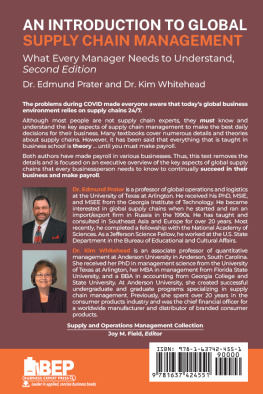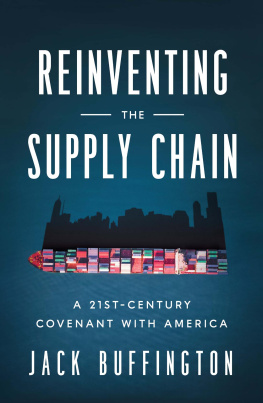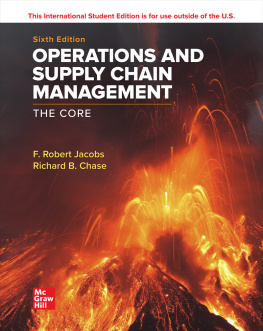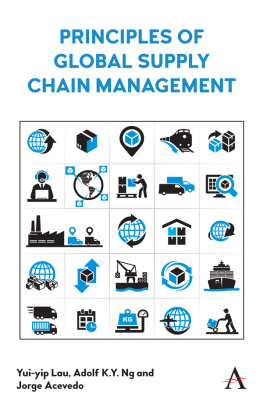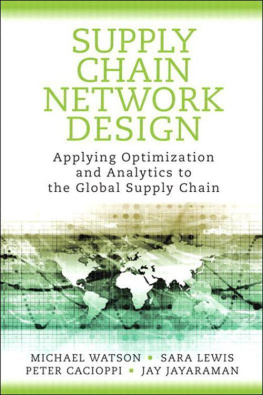An Introduction to Global Supply Chain Management, Second Edition
An Introduction to Global Supply Chain Management, Second Edition
What Every Manager Needs to Understand
Edmund Prater and Kim Whitehead

An Introduction to Global Supply Chain Management:
What Every Manager Needs to Understand, Second Edition
Copyright Business Expert Press, LLC, 2023.
Cover design by Charlene Kronstedt
Interior design by Exeter Premedia Services Private Ltd., Chennai, India
All rights reserved. No part of this publication may be reproduced, stored in a retrieval system, or transmitted in any form or by any meanselectronic, mechanical, photocopy, recording, or any other except for brief quotations, not to exceed 400 words, without the prior permission of the publisher.
First published in 2013 by
Business Expert Press, LLC
222 East 46th Street, New York, NY 10017
www.businessexpertpress.com
ISBN-13: 978-1-63742-455-1 (paperback)
ISBN-13: 978-1-63742-456-8 (e-book)
Business Expert Press Supply and Operations Management Collection
Second edition: 2023
10 9 8 7 6 5 4 3 2 1
Description
The problems during COVID made everyone aware that todays global business environment relies on supply chains 24/7.
Although most people are not supply chain experts, they must know and understand the key aspects of supply chain management to make the best daily decisions for their business. Many textbooks cover numerous details and theories about supply chains. However, it has been said that everything that is taught in business school is theory until you must make payroll.
Both authors have made payroll in various businesses. Thus, this text removes the details and is focused on an executive overview of the key aspects of global supply chains that every businessperson needs to know to continually succeed in their business and make payroll.
In order to succeed today you must speak different languages. This doesnt necessarily mean Chinese, German, or English. Rather it refers to the need to speak accounting, finance, marketing, and operations. This book is written for the executive who is not a supply chain management (SCM) professional but who wants to learn more about his or her supply chain. We will do this by diving into some best practices, examples of how other companies have managed their supply chain, and getting an overall briefing on the state of the art in SCM today. Questions and topics will be brought up, which will help you have an informed discussion with the SCM professionals in your company. As prior supply chain and manufacturing executives and now educators, we hope to share with you a mix of our professional and academic experience and knowledge that will provide you a framework for understanding the placement of your supply chain within the global marketplace.
Keywords
global supply chain management; value chain perspective; forecasting; logistics; distribution; inventory management; supply chain uncertainty; chaos management; supply chain coping strategies; information technology in supply chains; customer service within supply chains
Contents
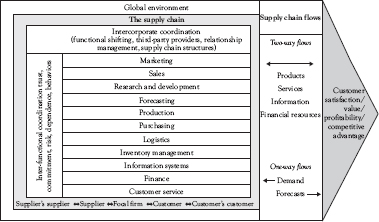
Chapter Objectives
Define terminology
Introduce the concept of supply chain management
Explore the pillars that support excellent supply chain management (SCM)
Lay the foundation for the introduction of supply chain strategy
It is impossible to carry on a discussion of the current business environment without the term supply chain coming up. Warren Hausman of Stanford University sums it up well when he states that Todays competition is not really company vs. company but supply chain vs. supply chain. Yet, what do we mean when we say, supply chain and what is required to manage one?
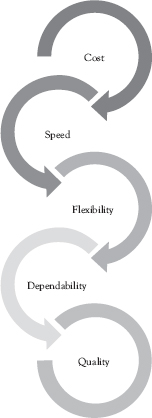
History of Supply Chain Management
Jay Forrester was considered the first person in academic literature to introduce the mindset of what is considered the supply chain view, in his seminal paper published in the Harvard Business Review.1 The term supply chain management was first used by two consultants by the names of Oliver and Webber in 1982. However, this term did not just magically come into being. Instead, Oliver and Webber had a good view of the future because they were standing on the shoulders of the Japanese and the just-in-time (JIT) revolution of the 1970s. In order to get a better understanding of what constitutes a supply chain, consider the role of traditional performance indicators and how they function within business processes. Each is singularly important, but yet, each is dependent on one another within an interdependent system.
Given this reality, how should we respond and manage them?
The Japanese responded with a process known as JIT inventory controls. The goal of JIT is to produce products at the right time, at the right quantity, and with perfect quality. Likewise, the goal of SCM is at the right product, at the right time, at the right place, at a competitive price. Continuing this idea, in migrating from JIT to SCM, the following views must change:
From flow-oriented to interfaces structure-oriented;
From plant-oriented to relationship-oriented;
From production-oriented to customer service-oriented.
But How Do You Make This Change?
SCM is concerned with the relationship between a company and its upstream and downstream partners; building relationships helps companies coordinate (work jointly) with their trading partners to integrate activities along the supply chain, to supply its customers with products effectively.
Who are these partners? As can be seen in Phase 1 of , a supply chain consists of a company and its suppliers and customers. This can be extended. Your immediate customer may have other customers of its own, while your supplier may have other subsuppliers. This general structure can be extended to include five general categories.
Producer
This is the company that either manufactures some product (such as a lawnmower) or provides some service (such as a lawn-mowing company).
Distributor
Purchases bulk quantities of manufactured goods from the producer and sells to other companies in large quantitiesmuch larger than individuals would purchasealso known as a wholesaler.
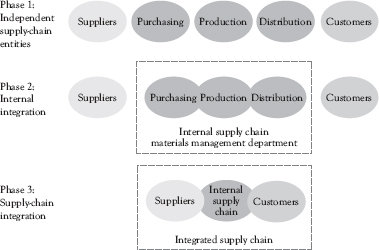
Figure 1.1 Supply chain relationships
Customer
A customer may be an individual who buys a product for personal use of an organization that buys products to be used to build other products of their own manufacture.
Service Provider
There are a host of providers of services in areas such as logistics, finance, HR management, IT support, marketing, design, and the list goes on.
In Phase 2, a firm begins to realize that instead of treating each part of the supply chain as a separate entity, it should begin to integrate functions. This allows firms to look for solutions that are best for the company as a whole, not just whats best for each individual department.

